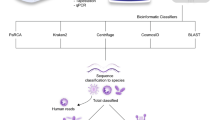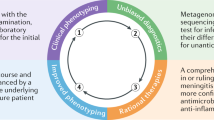Abstract
A brain abscess is a life-threatening infection, frequently with serious sequelae. Culture-based methods present many limitations and do not enable an exhaustive documentation of the bacterial flora. 16S rRNA-based amplification, cloning, and high-throughput sequencing have dramatically increased the number of identified agents of brain abscesses, showing that the causative flora is polymicrobial in up to 40 % of cases, with the presence of at least one anaerobic bacterium. In contrast, real-time polymerase chain reaction (PCR) technology is an appealing alternative to culture-based methods for diagnosing brain abscesses due to its speed, sensitivity, and specificity. Molecular typing is available for several bacterial and fungal genera, and this user-friendly tool is accessible for the clinical microbiology laboratory to diagnose microbes involved in a brain abscess. This article reviews the applications of the currently available tools for the etiological diagnosis of a brain abscess.

Similar content being viewed by others
Change history
06 October 2020
An erratum to this paper has been published: https://doi.org/10.1007/s10096-020-04047-8.
References
Mathisen GE, Johnson JP (1997) Brain abscess. Clin Infect Dis 25:763–779
Carpenter J, Stapleton S, Holliman R (2007) Retrospective analysis of 49 cases of brain abscess and review of the literature. Eur J Clin Microbiol Infect Dis 26:1–11
Goodkin HP, Harper MB, Pomeroy SL (2004) Intracerebral abscess in children: historical trends at Children’s Hospital Boston. Pediatrics 113:1765–1770
Tseng JH, Tseng MY (2006) Brain abscess in 142 patients: factors influencing outcome and mortality. Surg Neurol 65:557–562
Xiao F, Tseng MY, Teng LJ et al (2005) Brain abscess: clinical experience and analysis of prognostic factors. Surg Neurol 63:442–449
Al Masalma M, Armougom F, Scheld WM et al (2009) The expansion of the microbiological spectrum of brain abscesses with use of multiple 16S ribosomal DNA sequencing. Clin Infect Dis 48:1169–1178
Al Masalma M, Raoult D, Roux V (2009) Phocaeicola abscessus gen. nov., sp. nov., an anaerobic bacterium isolated from a human brain abscess sample. Int J Syst Evol Microbiol 59:2232–2237
Al Masalma M, Raoult D, Roux V (2010) Staphylococcus massiliensis sp. nov., isolated from a human brain abscess. Int J Syst Evol Microbiol 60:1066–1072
Mishra AK, Fournier PE (2013) The role of Streptococcus intermedius in brain abscess. Eur J Clin Microbiol Infect Dis 32:477–483
Prasad KN, Mishra AM, Gupta D et al (2006) Analysis of microbial etiology and mortality in patients with brain abscess. J Infect 53:221–227
Tonon E, Scotton PG, Gallucci M et al (2006) Brain abscess: clinical aspects of 100 patients. Int J Infect Dis 10:103–109
Lu CH, Chang WN, Lin YC et al (2002) Bacterial brain abscess: microbiological features, epidemiological trends and therapeutic outcomes. QJM 95:501–509
Kommedal Ø, Kvello K, Skjåstad R et al (2009) Direct 16S rRNA gene sequencing from clinical specimens, with special focus on polybacterial samples and interpretation of mixed DNA chromatograms. J Clin Microbiol 47:3562–3568
Koffi N, Aka-Danguy E, Ngom A et al (1998) Prevalence of nocardiosis in an area of endemic tuberculosis. Rev Mal Respir 15:643–647
Giraffa G, Neviani E (2001) DNA-based, culture-independent strategies for evaluating microbial communities in food-associated ecosystems. Int J Food Microbiol 67:19–34
Lagier JC, Armougom F, Million M et al (2012) Microbial culturomics: paradigm shift in the human gut microbiome study. Clin Microbiol Infect 18:1185–1193
Hall KK, Lyman JA (2006) Updated review of blood culture contamination. Clin Microbiol Rev 19:788–802
Seng P, Drancourt M, Gouriet F et al (2009) Ongoing revolution in bacteriology: routine identification of bacteria by matrix-assisted laser desorption ionization time-of-flight mass spectrometry. Clin Infect Dis 49:543–551
Arends JE, Stemerding AM, Vorst SP et al (2011) First report of a brain abscess caused by Nocardia veterana. J Clin Microbiol 12:4364–4365
Relman DA, Loutit JS, Schmidt TM et al (1990) The agent of bacillary angiomatosis. An approach to the identification of uncultured pathogens. N Engl J Med 323:1573–1580
Nikkari S, Lopez FA, Lepp PW et al (2002) Broad-range bacterial detection and the analysis of unexplained death and critical illness. Emerg Infect Dis 8:188–194
Petti CA, Simmon KE, Bender J et al (2008) Culture-negative intracerebral abscesses in children and adolescents from Streptococcus anginosus group infection: a case series. Clin Infect Dis 46:1578–1580
Tsai JC, Teng LJ, Hsueh PR (2008) Direct detection of bacterial pathogens in brain abscesses by polymerase chain reaction amplification and sequencing of partial 16S ribosomal deoxyribonucleic acid fragments. Neurosurgery 62:547–555
Kupila L, Rantakokko-Jalava K, Jalava J et al (2003) Aetiological diagnosis of brain abscesses and spinal infections: application of broad range bacterial polymerase chain reaction analysis. J Neurol Neurosurg Psychiatry 74:728–733
Harris KA, Hartley JC (2003) Development of broad-range 16S rDNA PCR for use in the routine diagnostic clinical microbiology service. J Med Microbiol 52:685–691
Bittar F, Richet H, Dubus JC et al (2008) Molecular detection of multiple emerging pathogens in sputa from cystic fibrosis patients. PLoS One 3:e2908
Fredricks DN, Fiedler TL, Marrazzo JM (2005) Molecular identification of bacteria associated with bacterial vaginosis. N Engl J Med 353:1899–1911
Siala M, Gdoura R, Fourati H et al (2009) Broad-range PCR, cloning and sequencing of the full 16S rRNA gene for detection of bacterial DNA in synovial fluid samples of Tunisian patients with reactive and undifferentiated arthritis. Arthritis Res Ther 11:R102
Ribeiro AC, Matarazzo F, Faveri M et al (2011) Exploring bacterial diversity of endodontic microbiota by cloning and sequencing 16S rRNA. J Endod 37:922–926
Eckburg PB, Bik EM, Bernstein CN et al (2005) Diversity of the human intestinal microbial flora. Science 308:1635–1638
Cole JR, Chai B, Farris RJ et al (2005) The Ribosomal Database Project (RDP-II): sequences and tools for high-throughput rRNA analysis. Nucleic Acids Res 33:D294–D296
Rasschaert G, Houf K, Imberechts H et al (2005) Comparison of five repetitive-sequence-based PCR typing methods for molecular discrimination of Salmonella enterica isolates. J Clin Microbiol 43:3615–3623
Borneman AR, Desany BA, Riches D et al (2011) Whole-genome comparison reveals novel genetic elements that characterize the genome of industrial strains of Saccharomyces cerevisiae. PLoS Genet 7:e1001287
Harvey BS, Koeuth T, Versalovic J et al (1995) Vertical transmission of Citrobacter diversus documented by DNA fingerprinting. Infect Control Hosp Epidemiol 16:564–569
Rodriguez-Barradas MC, Hamill RJ, Houston ED et al (1995) Genomic fingerprinting of Bartonella species by repetitive element PCR for distinguishing species and isolates. J Clin Microbiol 33:1089–1093
Pukall R, Brambilla E, Stackebrandt E (1998) Automated fragment length analysis of fluorescently-labeled 16S rDNA after digestion with 4-base cutting restriction enzymes. J Microbiol Methods 32:55–63
Pelaez AI, del Mar Garcia-Suarez M, Manteca A et al (2009) A fatal case of Nocardia otitidiscaviarum pulmonary infection and brain abscess: taxonomic characterization by molecular techniques. Ann Clin Microbiol Antimicrob 8:11
Sheng WH, Huang YT, Chang SC et al (2009) Brain abscess caused by Tsukamurella tyrosinosolvens in an immunocompetent patient. J Clin Microbiol 47:1602–1604
Marques da Silva R, Caugant DA, Josefsen R et al (2004) Characterization of Streptococcus constellatus strains recovered from a brain abscess and periodontal pockets in an immunocompromised patient. J Periodontol 75:1720–1723
Olive DM, Bean P (1999) Principles and applications of methods for DNA-based typing of microbial organisms. J Clin Microbiol 37:1661–1669
Brown-Elliott BA, Brown JM, Conville PS et al (2006) Clinical and laboratory features of the Nocardia spp. based on current molecular taxonomy. Clin Microbiol Rev 19:259–282
Enersen M, Olsen I, van Winkelhoff AJ et al (2006) Multilocus sequence typing of Porphyromonas gingivalis strains from different geographic origins. J Clin Microbiol 44:35–41
Feil EJ, Spratt BG (2001) Recombination and the population structures of bacterial pathogens. Annu Rev Microbiol 55:561–590
Bowen AB, Braden CR (2006) Invasive Enterobacter sakazakii disease in infants. Emerg Infect Dis 12:1185–1189
Nishihara T, Koseki T (2004) Microbial etiology of periodontitis. Periodontol 2000 36:14–26
Iida Y, Honda K, Suzuki T et al (2004) Brain abscess in which Porphyromonas gingivalis was detected in cerebrospinal fluid. Br J Oral Maxillofac Surg 42:180
Scannapieco FA, Bush RB, Paju S (2003) Associations between periodontal disease and risk for nosocomial bacterial pneumonia and chronic obstructive pulmonary disease. A systematic review. Ann Periodontol 8:54–69
Enright MC, Day NP, Davies CE et al (2000) Multilocus sequence typing for characterization of methicillin-resistant and methicillin-susceptible clones of Staphylococcus aureus. J Clin Microbiol 38:1008–1015
Sifri CD, Park J, Helm GA et al (2007) Fatal brain abscess due to community-associated methicillin-resistant Staphylococcus aureus strain USA300. Clin Infect Dis 45:e113–e117
McDowell A, Gao A, Barnard E et al (2011) A novel multilocus sequence typing scheme for the opportunistic pathogen Propionibacterium acnes and characterization of type I cell surface-associated antigens. Microbiology 157:1990–2003
Xirogianni A, Tzanakaki G, Karagianni E et al (2009) Development of a single-tube polymerase chain reaction assay for the simultaneous detection of Haemophilus influenzae, Pseudomonas aeruginosa, Staphylococcus aureus, and Streptococcus spp. directly in clinical samples. Diagn Microbiol Infect Dis 63:121–126
Pritzker AS, Kim BK, Agrawal D et al (2004) Fatal granulomatous amebic encephalitis caused by Balamuthia mandrillaris presenting as a skin lesion. J Am Acad Dermatol 50:S38–S41
Qvarnstrom Y, Visvesvara GS, Sriram R et al (2006) Multiplex real-time PCR assay for simultaneous detection of Acanthamoeba spp., Balamuthia mandrillaris, and Naegleria fowleri. J Clin Microbiol 44:3589–3595
Aliyu SH, Yong PKF, Newport MJ et al (2005) Molecular diagnosis of Fusobacterium necrophorum infection (Lemierre’s syndrome). Eur J Clin Microbiol Infect Dis 24:226–229
Pascual A, Jaton K, Ninet B et al (2010) New diagnostic real-time PCR for specific detection of Mycoplasma hominis DNA. Int J Microbiol 2010:317512
van Haeften R, Palladino S, Kay I et al (2003) A quantitative LightCycler PCR to detect Streptococcus pneumoniae in blood and CSF. Diagn Microbiol Infect Dis 47:407–414
Kroll JS, Loynds BM, Moxon ER et al (1991) The Haemophilus influenzae capsulation gene cluster: a compound transposon. Mol Microbiol 5:1549–1560
Jaton K, Sahli R, Bille J (1992) Development of polymerase chain reaction assays for detection of Listeria monocytogenes in clinical cerebrospinal fluid samples. J Clin Microbiol 30:1931–1936
Dore N, Bennett D, Kaliszer M et al (2003) Molecular epidemiology of group B streptococci in Ireland: associations between serotype, invasive status and presence of genes encoding putative virulence factors. Epidemiol Infect 131:823–833
Conflict of interest
The authors declare that they have no conflict of interest.
Author information
Authors and Affiliations
Corresponding author
Rights and permissions
About this article
Cite this article
Mishra, A.K., Dufour, H., Roche, PH. et al. Molecular revolution in the diagnosis of microbial brain abscesses. Eur J Clin Microbiol Infect Dis 33, 2083–2093 (2014). https://doi.org/10.1007/s10096-014-2166-z
Received:
Accepted:
Published:
Issue Date:
DOI: https://doi.org/10.1007/s10096-014-2166-z




